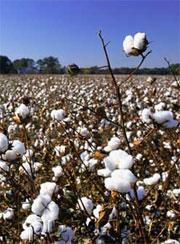 Making cotton resistant to bollworm can leave it open to other insect attacks.© Punchstock
Making cotton resistant to bollworm can leave it open to other insect attacks.© PunchstockAfter 7 years of planting cotton genetically engineered to kill bollworms, other insects have boomed so much on Chinese farms that their owners are losing money.
The new finding, from a study of nearly 500 cotton farmers, is likely to be controversial because it suggests that the genetically modified (GM) Bt cotton, named for the Bacillus thuringiensis bacterial gene it contains, doesn't live up to the agricultural success story suggested by some earlier studies.
China was the second country after the United States to adopt Bt cotton, in 1997. After 2 or 3 years of use, studies showed that the cotton had dramatically boosted yield and helped farmers to cut their use of insecticides by as much as 70%, saving money and protecting both people and the environment from the toxic chemicals.
The new study, conducted 7 years after the cotton's introduction, paints a gloomier picture of the crop's economic impact. Per Pinstrup-Andersen and his colleagues at Cornell University in Ithaca, New York, worked with Chinese agricultural researchers to interview cotton farmers about their finances and insecticide use in 2004.
The researchers found that populations of other cotton pests, particularly ones called mirids, have blossomed. These were once killed by the same broad-spectrum pesticides used to control the bollworm. Now, farmers are spending almost as much on pesticides to control these secondary pests as those farmers growing regular cotton.
Because Bt seed is more expensive, this means that the Bt cotton farmers have a net average income that is 8% lower than farmers growing conventional cotton. "It's kind of a shock," says team member Shenghui Wang, who presented the results today at the American Agricultural Economics Association Annual Meeting in Long Beach, California.
Run amok
Because the Bt toxin engineered into GM cotton only kills bollworms, experts knew that other insect populations might run amok after pesticide use was scaled back. But they say that it is hard to predict the effects, because the type and numbers of other pests vary from one region to another.
In the United States, farmers using Bt cotton have also seen a rise in populations of secondary pests, particularly whitefly and a type of mirid, says entomologist Yves Carrière, who studies Bt cotton at the University of Arizona, Tucson. But this does not seem to have had the same detrimental impact as it has had in China, partly because these secondary pests are carefully monitored in order to decide when pesticides are needed.
The study raises fears that explosions of secondary pests will also gradually erode the benefits of <i>Bt</i> cotton in other countries where it has been adopted, such as India and South Africa. "We are concerned that the same problem will crop up elsewhere," Pinstrup-Andersen says; and perhaps, he adds, also in the use of other Bt crops such as maize.
Fuelling the fire
Pinstrup-Anderson says that he expects the new study to be contentious because it adds to some people's existing concerns about the use of GM Bt crops: the risk of the Bt gene contaminating other plants, the risk of encouraging survival of bollworms resistant to the toxin, and other unanticipated effects on insects, plants and other animals.
But, argues Pinstrup-Anderson, Bt cotton should not be abandoned, because it is still successful at controlling the bollworm. He says that researchers, farmers and policy-makers now need to find ways to control the secondary pests by, for example, introducing natural predators of the mirids, or engineering a second generation of Bt cotton that kills the other pests.
ADVERTISEMENT
Another idea, the researchers suggest, is to use refuges, which are small pockets of land used to grow conventional cotton alongside Bt cotton. These are already mandatory for US farmers in order to maintain a population of insects not exposed to the Bt toxin and help prevent the development of toxin-resistant insects. In China, refuges might be sprayed with pesticides to prevent the other pests spiralling out of control.
Visit our cottondrives_insec.html">newsblog to read and post comments about this story.
